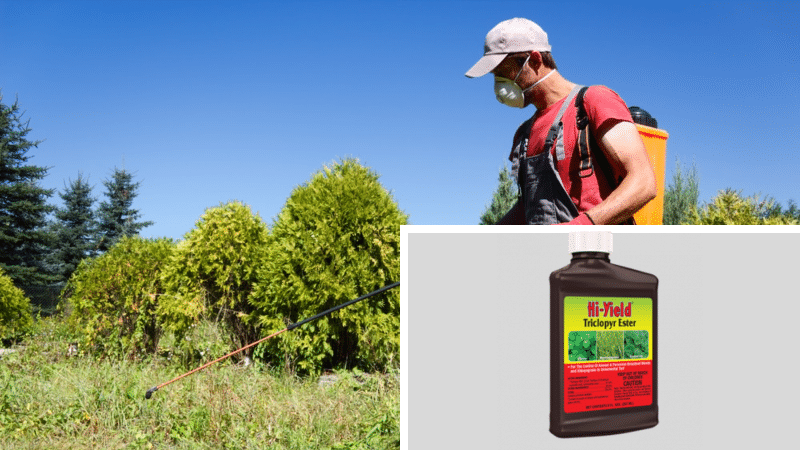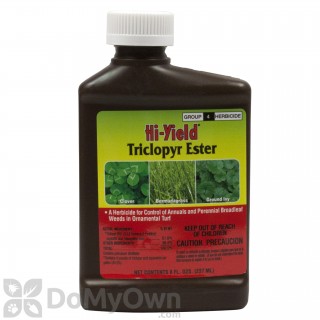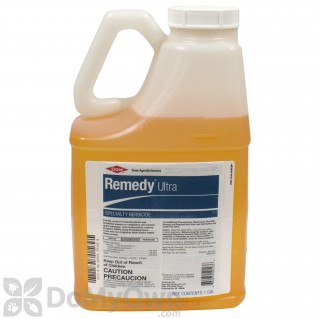Sick of poison ivy growing on your lawn? Want to be able to wander freely about your property without worrying about blackberry brambles clawing at your legs? Or perhaps your yard is 75% clover and you would like more grass instead. If so, it might be time to apply an herbicide that targets both woody and broadleaf plants.
You’ll have plenty of options to choose from, but when it comes to controlling woody and broadleaf plants, Triclopyr is one of the best products to choose. It works quickly and can get rid of dozens of different kinds of plants.
Here are some tips on how to use it on your property and some of the best products you can choose from – regardless of the type of weed you are trying to control.
What is Triclopyr?
Triclopyr is a unique man-made herbicide that is meant to control woody and broadleaf plants. It’s been around for quite a while, first registered in the late 1970s for use in forestry, agricultural, and non-agricultural settings.
It can control a wide variety of plants, including docks, brambles, nettles, and other woody plants. Since it is a selective herbicide, it controls only certain types of plants. Most grasses aren’t that sensitive to Triclopyr so in most cases, you can use it on your lawn without damaging your grass.
There are more than 200 different products that contain Triclopyr, with many including other active ingredients in addition to the Triclopyr. You may find these formulated as ready-to-use or concentrated liquids, granules, or even mixable powders. They can be applied in an aerial fashion or by a ground application.
There are even some Triclopyr products that are meant to be sprayed on plant leaves, injected or painted onto tree trunks or soil, or applied to tree bark.
You may find Triclopyr products with ester, salt, or acid forms, but all are similar in terms of toxicity and how they work. This herbicide is frequently used on pastures and uniquely, on rice paddies. It can also be used for landscaping, lawn care, and turf.
The most common types of Triclopyr are amine and ester. These vary in terms of the species they can treat as well as the best methods of application. Ester variations tend to be best at penetrating through tough bark, making them ideal for basal bark, cut stem, and foliar applications, while amine variations are ideal for turf settings (they also drift less).

How Does Triclopyr Work?
Triclopyr works much like other herbicides in that it imitates an essential plant growth hormone known as auxin. It causes the target plant to suffer abnormal growth, making it grow much faster than it should.
Ultimately, this overwhelms the plant and causes it to die. It is a systemic herbicide that is absorbed through a plant’s roots and leaves.
In most cases, Triclopyr takes a few weeks to fully kill a plant.
Benefits of Triclopyr
There are multiple benefits associated with using Triclopyr on your most stubborn weeds.
For one it is a selective postemergence herbicide, targeting very specific weeds without causing harmful effects to desired vegetation. It works quickly and effectively against brushing, eliminating the need to manually pull, cut, or trim back weeds (techniques that are notorious for being time-consuming and back-killing!).
Triclopyr works quickly, too. Although it does take a couple of weeks to fully kill a targeted species, this herbicide works faster than a common alternative, glyphosate, in getting rid of problems.
You can use this herbicide on residential and commercial properties, including on industrial sites, around pastures and rangelands, and even on rights-of-way. There are even certain formulations of this product that are designed for use on aquatic weeds!
Drawbacks of Triclopyr
There aren’t many drawbacks of using Triclopyr on your plants!
However, you do need to be sure to read all instructions for your chosen product carefully. That’s because Tirclopyr is extremely potent and reapplying it is much easier than you might think. Be careful when applying Triclopyr near desired plants and shrubs, since it can often kill them, too.
The only other potential downside of using Triclopyr is that it acts quickly. If you need a faster method of getting rid of unwanted vegetation, you may have to try a different product (or exercise some patience) to get the job done.
What Weeds Will Triclopyr Kill?
Triclopyr can kill many different kinds of weeds and unwanted plants, however it is mainly used to control invasive woody/vine species and ground clover. While it can kill the more common dandelions, there are better alternatives to combat these including Dithiopyr. With that said, some of the most common weeds targeted by Triclopyr applicators include:
- Poison ivy
- Poison oak
- Nettles
- Docks
- Brambles
- Wild violet
- Wild carrot
- Kikuyu Grass
- Plantain
- Ground ivy
- Dandelion
- Clover
- Bull thistle
- Black medic
- Ragweed
…and many more!
Best Triclopyr Products to Consider
1. Hi-Yield Triclopyr Ester

Use HI-YIELD Triclopyr Ester previously known as Turflon Ester Ultra herbicide for the control of actively growing annual and perennial broadleaf weeds and kikuyugrass in perennial bluegrass, perennial ryegrass, or tall fescue ornamental turf including these turfgrasses in golf courses.
Why DoMyOwn?DoMyOwn.com offers professional-grade insecticides to DIYers while ensuring proper storage of chemicals. Couple that with their impressive customer service and knowledgeable staff, it’s the #1 choice.
Formerly known as Turflon Ester Ultra, this herbicide by Hi-Yield is one of the most effective ones you can use on actively growing broadleaf weeds, both perennial and annual. It targets species like kikuyugrass and other weeds that might be growing in perennial ryegrass, bluegrass, or tall fescue.
It can be used both as a regular treatment as well as a spot treatment, meant to be applied at a rate of ⅜-¾ oz per one gallon of water for every 1000 square feet. It’s pet-safe when used as directed and is sold in an eight-ounce bottle that’s the perfect size for the average homeowner.
Features:
- Contains Triclopyr and butoxyethyl ester 60.45%
- Target species like bull thistle, black medic, dandelion, clover, kikuyugrass, plantain, and more
- Use as a spot treatment or for regular control
Pros:
- Pet-safe product
- Easy to apply
- Only requires 8-16 oz per acre
Cons:
- Best for cool-season grasses
- Does not ship to Alaska, Arizona, Arkansas, Washington, D.C., Hawaii, Louisiana, Maryland, Montana, North Dakota, New Hampshire, New Mexico, Nevada, Rhode Island, or Vermont
2. Helena Crossbow Herbicide

Crossbow is a non-selective post-emergent herbicide that targets woody plants and brush such as blackberries and poison oak, as well as annual and perennial broadleaves, while leaving grasses unharmed.
Why DoMyOwn?DoMyOwn.com offers professional-grade insecticides to DIYers while ensuring proper storage of chemicals. Couple that with their impressive customer service and knowledgeable staff, it’s the #1 choice.
A non-selective post-emergent herbicide, Helena Crossbow Herbicide is most effective against brush and wood plants like poison oak, blackberries, and perennial broadleaves. It can be used in all kinds of settings and even ins prayers, including both tractor-mounted rigs and handheld models.
This is one of the few Triclopyr products that is safe to use around grazing animals, with the exception of lactating dairy animals. It’s also rainfast within two hours of application, making it both easy and convenient to apply.
It can be used on all kinds of noncrop areas, including fence rows, grass pastures, rangeland, roadside, and more, though it’s important to note that it’s not meant for use on home lawns.
Features:
- Sold in a 128 oz gallon size
- Apply at a rate of 1-4 gallons per 100 gallons of water
- Controls all kinds of pests including henbit, clover, chickweed, plantain, wild carrot, thistle, and more
Pros:
- Best product for pastures and rangelands
- Rainfast within two hours of application
- Easy to apply with a sprayer
Cons:
- Does not ship to Texas, Rhode Island, Nevada, New Mexico, New Hampshire, California, Arizona, or Alaska
- Not meant for home lawns
3. Bonide Stump Out Stump & Vine Killer

Bonide Stump Out Stump & Vine Killer is formulated to provide permanent and complete control of stumps (prevents resprouting), vines, brush, kudzu, and broadleaf weeds.
Why DoMyOwn?DoMyOwn.com offers professional-grade insecticides to DIYers while ensuring proper storage of chemicals. Couple that with their impressive customer service and knowledgeable staff, it’s the #1 choice.
If you want to double up on your lawn care chores and are looking for a product that will kill weeds as well as vines, stumps, and other nuisance plants, then this Triclopyr product by Bonide is the way to go.
It contains 8.8% triethylamine salt and Triclopyr, targeting all kinds of vines, woody plants, and broadleaf weeds. It can be used around homes, fences, walkways, and other noncrop areas and is pet-safe when used as directed.
Simply combine about four to eight ounces per gallon of water for every 500 square feet and watch it quickly kill all the unwanted plants that are lingering on your property!
Features:
- Sold by the individual eight-ounce bottle as well as by the case
- Can be used as a foliar spray, for vine control, or as a stump treatment
Pros:
- Multipurpose product targets all kinds of invasive and weed species
- Can be used on any non-crop area
- Pet-safe
Cons:
- Not sold in Alaska, Vermont, and Hawaii
4. Remedy Ultra Herbicide

Controlling for more than 35 different species of brush weeds, Remedy Ultra Herbicide works great on established grass, destroying the weeds while improving the growth of the grass, so long as it is properly watered.
Why DoMyOwn?DoMyOwn.com offers professional-grade insecticides to DIYers while ensuring proper storage of chemicals. Couple that with their impressive customer service and knowledgeable staff, it’s the #1 choice.
An oil-soluble herbicide, Remedy Ultra Herbicide by Coreteva controls both broadleaf and woody weeds in all kinds of outdoor commercial and residential areas. Whether it’s rangeland or a weedy ditch bank that you’re trying to target, Remedy should do the job nicely.
It can be applied in a variety of ways, including as a foliar spray, as a cut stump application, or even by aerial broadcast.
It works well even on established grass and will improve the growth of your grass as long as it is properly watered. It can control more than 35 different species of brush weeds and should be applied at a rate of less than half a gallon per acre in areas where animals graze. Otherwise, you can apply up to eight quarts per acre per year.
Features:
- Sold in two sizes-128 oz and 2.5 gallon
- Contains 60.45% triclopyr and butoxyethyl ester
- Apply as a cut stump, basal bark, or foliar treatment
- Offers ¼ to 1 acre of coverage
Pros:
- Controls all kinds of broadleaf weeds and woody plant pests including alder, pepper vine, trumpet creeper, curly dock, wild carrot, and more
- Can be used on just about any kind of property
- Multiple application methods make this a multi-use product to save you time and money
Cons:
- Requires a surfactant for maximum efficacy
How To Apply Triclopyr
Triclopyr is easy to apply and it works quickly and systematically, working through plant tissues and killing the plant by affecting its growth and development.
Follow the instructions on your Triclopyr product when it comes time to apply. In most cases, you will need to apply about one to four quarts of Triclopyr to about five gallons of solution or water per acre. You can apply at any time that you notice weeds actively growing.
You should see results within two to three weeks, at which time the plant should be completely killed. However, you’ll likely notice a difference long before then, as plants may look weak and deformed before they die back entirely.
Is Triclopyr Safe?
When used as directed, Triclopyr is perfectly safe to use. Make sure you stay off the treated area until the product has completely dried and don’t use it in areas where pets or small children might be hanging out.
Be careful when mixing or applying Triclopyr that you don’t get it into your eyes or breathe it in. It can cause serious eye damage and irritation in any of its forms. It is low in toxicity on the skin as well as if inhaled, but it can cause problems when ingested.
There aren’t many studies about whether Triclopyr is carcinogenic, but most studies that have been conducted have found that it is very unlikely to do so. It breaks down quickly in the soil, having a half-life between eight and 46 days. It’s also non-toxic to bees, another benefit of using this product.
Of course, you should always wear protective equipment before applying this product, too. Protective glasses, gloves, and long sleeves are a must.
FAQ
Triclopyr works more quickly than glyphosate and while one is not necessarily safer than the other, there are fewer plants that are resistant to Triclopyr than there are to glyphosate.
There are hundreds of herbicides that contain Triclopyr, including Scrubcutter Grazon, Brush Off, Renovate, Victory, Release, Turflon, Pathfinder, Garlon, and more.
Triclopyr can kill many different kinds of broadleaf plants and woody weeds including ash, alder, maple, sweet gum, sumac, bull thistle, clover, and chicory.
Although you will begin to see the effects of Triclopyr shortly after your initial application, it generally takes about two to three weeks to ultimately kill a plant.

Comments
Loading…